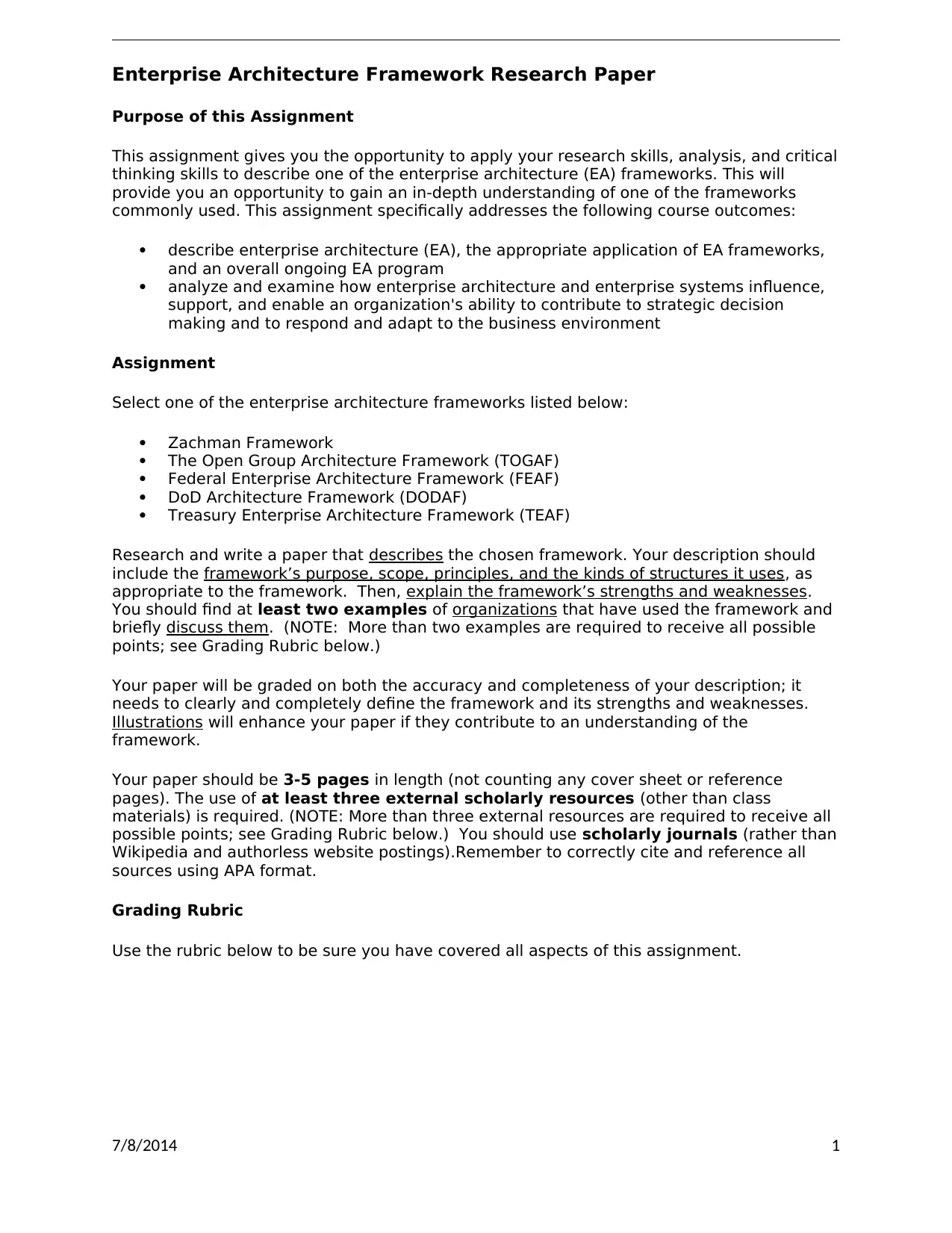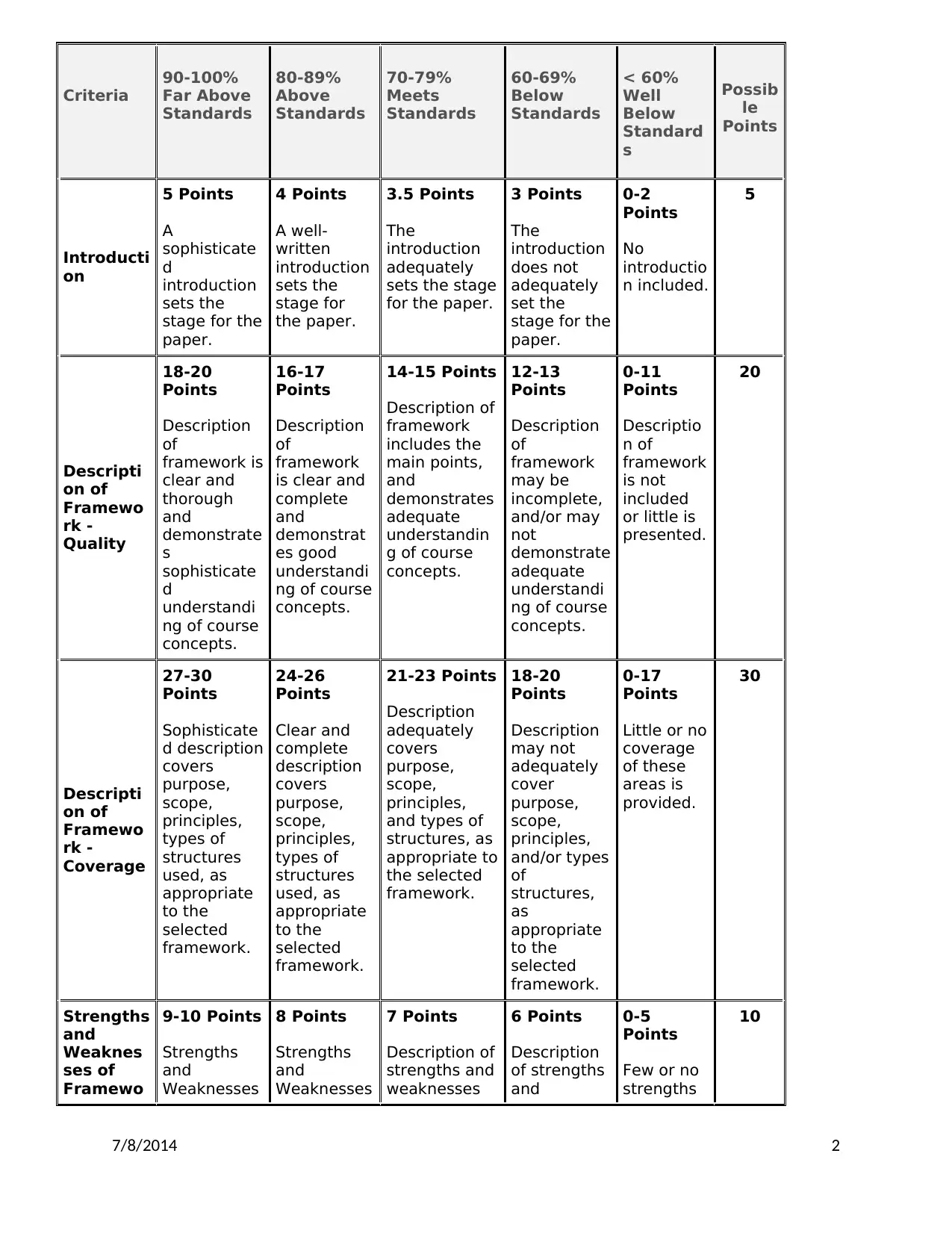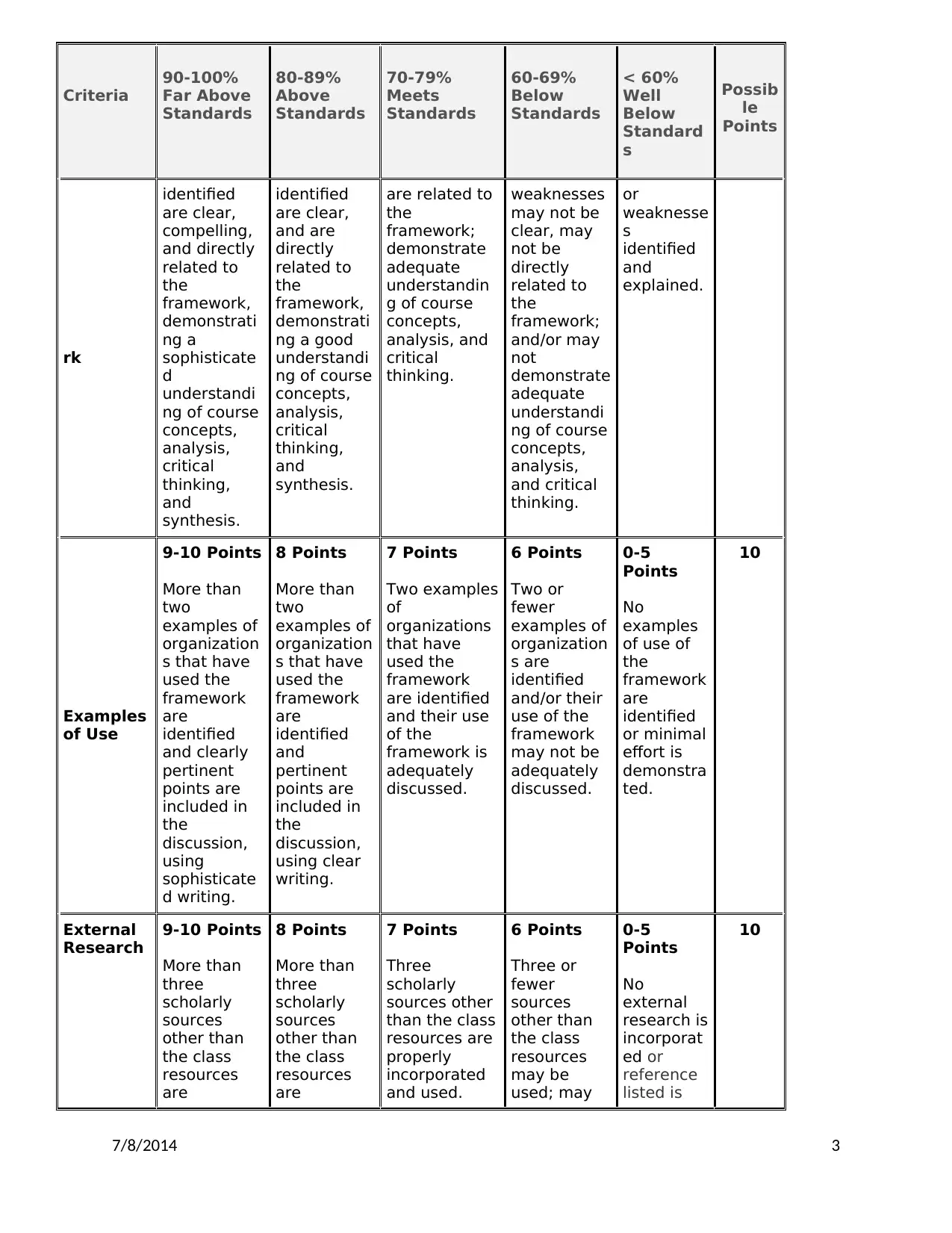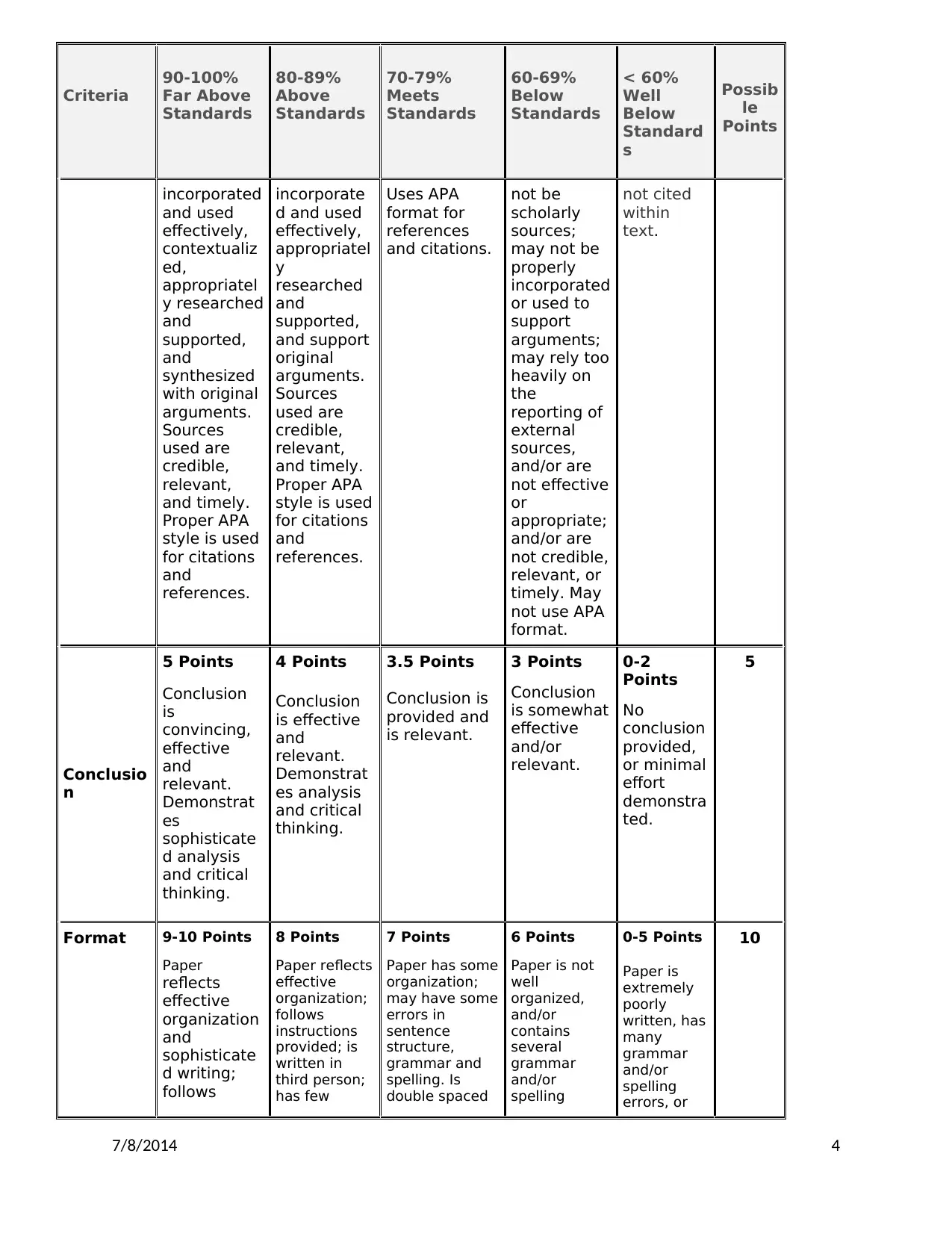Enterprise Architecture Framework Research Paper - BUS 500
VerifiedAdded on 2019/10/16
|5
|1395
|345
Report
AI Summary
This research paper delves into the realm of enterprise architecture (EA) frameworks, offering a comprehensive analysis of a chosen framework from the list: Zachman Framework, The Open Group Architecture Framework (TOGAF), Federal Enterprise Architecture Framework (FEAF), DoD Architecture Framework (DODAF), and Treasury Enterprise Architecture Framework (TEAF). The paper meticulously examines the framework's purpose, scope, and underlying principles, providing a clear understanding of its core components. It further explores the types of structures employed within the framework, offering insights into its practical application. A critical evaluation of the framework's strengths and weaknesses is presented, supported by a discussion of at least two real-world examples of organizations that have successfully implemented the framework. The paper's content is enriched by the inclusion of at least three scholarly sources, adhering to APA formatting guidelines for citations and references. The overall aim is to provide a detailed and well-supported understanding of the chosen EA framework, its utility, and its impact on strategic decision-making within organizations.

Enterprise Architecture Framework Research Paper
Purpose of this Assignment
This assignment gives you the opportunity to apply your research skills, analysis, and critical
thinking skills to describe one of the enterprise architecture (EA) frameworks. This will
provide you an opportunity to gain an in-depth understanding of one of the frameworks
commonly used. This assignment specifically addresses the following course outcomes:
describe enterprise architecture (EA), the appropriate application of EA frameworks,
and an overall ongoing EA program
analyze and examine how enterprise architecture and enterprise systems influence,
support, and enable an organization's ability to contribute to strategic decision
making and to respond and adapt to the business environment
Assignment
Select one of the enterprise architecture frameworks listed below:
Zachman Framework
The Open Group Architecture Framework (TOGAF)
Federal Enterprise Architecture Framework (FEAF)
DoD Architecture Framework (DODAF)
Treasury Enterprise Architecture Framework (TEAF)
Research and write a paper that describes the chosen framework. Your description should
include the framework’s purpose, scope, principles, and the kinds of structures it uses, as
appropriate to the framework. Then, explain the framework’s strengths and weaknesses.
You should find at least two examples of organizations that have used the framework and
briefly discuss them. (NOTE: More than two examples are required to receive all possible
points; see Grading Rubric below.)
Your paper will be graded on both the accuracy and completeness of your description; it
needs to clearly and completely define the framework and its strengths and weaknesses.
Illustrations will enhance your paper if they contribute to an understanding of the
framework.
Your paper should be 3-5 pages in length (not counting any cover sheet or reference
pages). The use of at least three external scholarly resources (other than class
materials) is required. (NOTE: More than three external resources are required to receive all
possible points; see Grading Rubric below.) You should use scholarly journals (rather than
Wikipedia and authorless website postings).Remember to correctly cite and reference all
sources using APA format.
Grading Rubric
Use the rubric below to be sure you have covered all aspects of this assignment.
7/8/2014 1
Purpose of this Assignment
This assignment gives you the opportunity to apply your research skills, analysis, and critical
thinking skills to describe one of the enterprise architecture (EA) frameworks. This will
provide you an opportunity to gain an in-depth understanding of one of the frameworks
commonly used. This assignment specifically addresses the following course outcomes:
describe enterprise architecture (EA), the appropriate application of EA frameworks,
and an overall ongoing EA program
analyze and examine how enterprise architecture and enterprise systems influence,
support, and enable an organization's ability to contribute to strategic decision
making and to respond and adapt to the business environment
Assignment
Select one of the enterprise architecture frameworks listed below:
Zachman Framework
The Open Group Architecture Framework (TOGAF)
Federal Enterprise Architecture Framework (FEAF)
DoD Architecture Framework (DODAF)
Treasury Enterprise Architecture Framework (TEAF)
Research and write a paper that describes the chosen framework. Your description should
include the framework’s purpose, scope, principles, and the kinds of structures it uses, as
appropriate to the framework. Then, explain the framework’s strengths and weaknesses.
You should find at least two examples of organizations that have used the framework and
briefly discuss them. (NOTE: More than two examples are required to receive all possible
points; see Grading Rubric below.)
Your paper will be graded on both the accuracy and completeness of your description; it
needs to clearly and completely define the framework and its strengths and weaknesses.
Illustrations will enhance your paper if they contribute to an understanding of the
framework.
Your paper should be 3-5 pages in length (not counting any cover sheet or reference
pages). The use of at least three external scholarly resources (other than class
materials) is required. (NOTE: More than three external resources are required to receive all
possible points; see Grading Rubric below.) You should use scholarly journals (rather than
Wikipedia and authorless website postings).Remember to correctly cite and reference all
sources using APA format.
Grading Rubric
Use the rubric below to be sure you have covered all aspects of this assignment.
7/8/2014 1
Paraphrase This Document
Need a fresh take? Get an instant paraphrase of this document with our AI Paraphraser

Criteria
90-100%
Far Above
Standards
80-89%
Above
Standards
70-79%
Meets
Standards
60-69%
Below
Standards
< 60%
Well
Below
Standard
s
Possib
le
Points
Introducti
on
5 Points
A
sophisticate
d
introduction
sets the
stage for the
paper.
4 Points
A well-
written
introduction
sets the
stage for
the paper.
3.5 Points
The
introduction
adequately
sets the stage
for the paper.
3 Points
The
introduction
does not
adequately
set the
stage for the
paper.
0-2
Points
No
introductio
n included.
5
Descripti
on of
Framewo
rk -
Quality
18-20
Points
Description
of
framework is
clear and
thorough
and
demonstrate
s
sophisticate
d
understandi
ng of course
concepts.
16-17
Points
Description
of
framework
is clear and
complete
and
demonstrat
es good
understandi
ng of course
concepts.
14-15 Points
Description of
framework
includes the
main points,
and
demonstrates
adequate
understandin
g of course
concepts.
12-13
Points
Description
of
framework
may be
incomplete,
and/or may
not
demonstrate
adequate
understandi
ng of course
concepts.
0-11
Points
Descriptio
n of
framework
is not
included
or little is
presented.
20
Descripti
on of
Framewo
rk -
Coverage
27-30
Points
Sophisticate
d description
covers
purpose,
scope,
principles,
types of
structures
used, as
appropriate
to the
selected
framework.
24-26
Points
Clear and
complete
description
covers
purpose,
scope,
principles,
types of
structures
used, as
appropriate
to the
selected
framework.
21-23 Points
Description
adequately
covers
purpose,
scope,
principles,
and types of
structures, as
appropriate to
the selected
framework.
18-20
Points
Description
may not
adequately
cover
purpose,
scope,
principles,
and/or types
of
structures,
as
appropriate
to the
selected
framework.
0-17
Points
Little or no
coverage
of these
areas is
provided.
30
Strengths
and
Weaknes
ses of
Framewo
9-10 Points
Strengths
and
Weaknesses
8 Points
Strengths
and
Weaknesses
7 Points
Description of
strengths and
weaknesses
6 Points
Description
of strengths
and
0-5
Points
Few or no
strengths
10
7/8/2014 2
90-100%
Far Above
Standards
80-89%
Above
Standards
70-79%
Meets
Standards
60-69%
Below
Standards
< 60%
Well
Below
Standard
s
Possib
le
Points
Introducti
on
5 Points
A
sophisticate
d
introduction
sets the
stage for the
paper.
4 Points
A well-
written
introduction
sets the
stage for
the paper.
3.5 Points
The
introduction
adequately
sets the stage
for the paper.
3 Points
The
introduction
does not
adequately
set the
stage for the
paper.
0-2
Points
No
introductio
n included.
5
Descripti
on of
Framewo
rk -
Quality
18-20
Points
Description
of
framework is
clear and
thorough
and
demonstrate
s
sophisticate
d
understandi
ng of course
concepts.
16-17
Points
Description
of
framework
is clear and
complete
and
demonstrat
es good
understandi
ng of course
concepts.
14-15 Points
Description of
framework
includes the
main points,
and
demonstrates
adequate
understandin
g of course
concepts.
12-13
Points
Description
of
framework
may be
incomplete,
and/or may
not
demonstrate
adequate
understandi
ng of course
concepts.
0-11
Points
Descriptio
n of
framework
is not
included
or little is
presented.
20
Descripti
on of
Framewo
rk -
Coverage
27-30
Points
Sophisticate
d description
covers
purpose,
scope,
principles,
types of
structures
used, as
appropriate
to the
selected
framework.
24-26
Points
Clear and
complete
description
covers
purpose,
scope,
principles,
types of
structures
used, as
appropriate
to the
selected
framework.
21-23 Points
Description
adequately
covers
purpose,
scope,
principles,
and types of
structures, as
appropriate to
the selected
framework.
18-20
Points
Description
may not
adequately
cover
purpose,
scope,
principles,
and/or types
of
structures,
as
appropriate
to the
selected
framework.
0-17
Points
Little or no
coverage
of these
areas is
provided.
30
Strengths
and
Weaknes
ses of
Framewo
9-10 Points
Strengths
and
Weaknesses
8 Points
Strengths
and
Weaknesses
7 Points
Description of
strengths and
weaknesses
6 Points
Description
of strengths
and
0-5
Points
Few or no
strengths
10
7/8/2014 2

Criteria
90-100%
Far Above
Standards
80-89%
Above
Standards
70-79%
Meets
Standards
60-69%
Below
Standards
< 60%
Well
Below
Standard
s
Possib
le
Points
rk
identified
are clear,
compelling,
and directly
related to
the
framework,
demonstrati
ng a
sophisticate
d
understandi
ng of course
concepts,
analysis,
critical
thinking,
and
synthesis.
identified
are clear,
and are
directly
related to
the
framework,
demonstrati
ng a good
understandi
ng of course
concepts,
analysis,
critical
thinking,
and
synthesis.
are related to
the
framework;
demonstrate
adequate
understandin
g of course
concepts,
analysis, and
critical
thinking.
weaknesses
may not be
clear, may
not be
directly
related to
the
framework;
and/or may
not
demonstrate
adequate
understandi
ng of course
concepts,
analysis,
and critical
thinking.
or
weaknesse
s
identified
and
explained.
Examples
of Use
9-10 Points
More than
two
examples of
organization
s that have
used the
framework
are
identified
and clearly
pertinent
points are
included in
the
discussion,
using
sophisticate
d writing.
8 Points
More than
two
examples of
organization
s that have
used the
framework
are
identified
and
pertinent
points are
included in
the
discussion,
using clear
writing.
7 Points
Two examples
of
organizations
that have
used the
framework
are identified
and their use
of the
framework is
adequately
discussed.
6 Points
Two or
fewer
examples of
organization
s are
identified
and/or their
use of the
framework
may not be
adequately
discussed.
0-5
Points
No
examples
of use of
the
framework
are
identified
or minimal
effort is
demonstra
ted.
10
External
Research
9-10 Points
More than
three
scholarly
sources
other than
the class
resources
are
8 Points
More than
three
scholarly
sources
other than
the class
resources
are
7 Points
Three
scholarly
sources other
than the class
resources are
properly
incorporated
and used.
6 Points
Three or
fewer
sources
other than
the class
resources
may be
used; may
0-5
Points
No
external
research is
incorporat
ed or
reference
listed is
10
7/8/2014 3
90-100%
Far Above
Standards
80-89%
Above
Standards
70-79%
Meets
Standards
60-69%
Below
Standards
< 60%
Well
Below
Standard
s
Possib
le
Points
rk
identified
are clear,
compelling,
and directly
related to
the
framework,
demonstrati
ng a
sophisticate
d
understandi
ng of course
concepts,
analysis,
critical
thinking,
and
synthesis.
identified
are clear,
and are
directly
related to
the
framework,
demonstrati
ng a good
understandi
ng of course
concepts,
analysis,
critical
thinking,
and
synthesis.
are related to
the
framework;
demonstrate
adequate
understandin
g of course
concepts,
analysis, and
critical
thinking.
weaknesses
may not be
clear, may
not be
directly
related to
the
framework;
and/or may
not
demonstrate
adequate
understandi
ng of course
concepts,
analysis,
and critical
thinking.
or
weaknesse
s
identified
and
explained.
Examples
of Use
9-10 Points
More than
two
examples of
organization
s that have
used the
framework
are
identified
and clearly
pertinent
points are
included in
the
discussion,
using
sophisticate
d writing.
8 Points
More than
two
examples of
organization
s that have
used the
framework
are
identified
and
pertinent
points are
included in
the
discussion,
using clear
writing.
7 Points
Two examples
of
organizations
that have
used the
framework
are identified
and their use
of the
framework is
adequately
discussed.
6 Points
Two or
fewer
examples of
organization
s are
identified
and/or their
use of the
framework
may not be
adequately
discussed.
0-5
Points
No
examples
of use of
the
framework
are
identified
or minimal
effort is
demonstra
ted.
10
External
Research
9-10 Points
More than
three
scholarly
sources
other than
the class
resources
are
8 Points
More than
three
scholarly
sources
other than
the class
resources
are
7 Points
Three
scholarly
sources other
than the class
resources are
properly
incorporated
and used.
6 Points
Three or
fewer
sources
other than
the class
resources
may be
used; may
0-5
Points
No
external
research is
incorporat
ed or
reference
listed is
10
7/8/2014 3
⊘ This is a preview!⊘
Do you want full access?
Subscribe today to unlock all pages.

Trusted by 1+ million students worldwide

Criteria
90-100%
Far Above
Standards
80-89%
Above
Standards
70-79%
Meets
Standards
60-69%
Below
Standards
< 60%
Well
Below
Standard
s
Possib
le
Points
incorporated
and used
effectively,
contextualiz
ed,
appropriatel
y researched
and
supported,
and
synthesized
with original
arguments.
Sources
used are
credible,
relevant,
and timely.
Proper APA
style is used
for citations
and
references.
incorporate
d and used
effectively,
appropriatel
y
researched
and
supported,
and support
original
arguments.
Sources
used are
credible,
relevant,
and timely.
Proper APA
style is used
for citations
and
references.
Uses APA
format for
references
and citations.
not be
scholarly
sources;
may not be
properly
incorporated
or used to
support
arguments;
may rely too
heavily on
the
reporting of
external
sources,
and/or are
not effective
or
appropriate;
and/or are
not credible,
relevant, or
timely. May
not use APA
format.
not cited
within
text.
Conclusio
n
5 Points
Conclusion
is
convincing,
effective
and
relevant.
Demonstrat
es
sophisticate
d analysis
and critical
thinking.
4 Points
Conclusion
is effective
and
relevant.
Demonstrat
es analysis
and critical
thinking.
3.5 Points
Conclusion is
provided and
is relevant.
3 Points
Conclusion
is somewhat
effective
and/or
relevant.
0-2
Points
No
conclusion
provided,
or minimal
effort
demonstra
ted.
5
Format 9-10 Points
Paper
reflects
effective
organization
and
sophisticate
d writing;
follows
8 Points
Paper reflects
effective
organization;
follows
instructions
provided; is
written in
third person;
has few
7 Points
Paper has some
organization;
may have some
errors in
sentence
structure,
grammar and
spelling. Is
double spaced
6 Points
Paper is not
well
organized,
and/or
contains
several
grammar
and/or
spelling
0-5 Points
Paper is
extremely
poorly
written, has
many
grammar
and/or
spelling
errors, or
10
7/8/2014 4
90-100%
Far Above
Standards
80-89%
Above
Standards
70-79%
Meets
Standards
60-69%
Below
Standards
< 60%
Well
Below
Standard
s
Possib
le
Points
incorporated
and used
effectively,
contextualiz
ed,
appropriatel
y researched
and
supported,
and
synthesized
with original
arguments.
Sources
used are
credible,
relevant,
and timely.
Proper APA
style is used
for citations
and
references.
incorporate
d and used
effectively,
appropriatel
y
researched
and
supported,
and support
original
arguments.
Sources
used are
credible,
relevant,
and timely.
Proper APA
style is used
for citations
and
references.
Uses APA
format for
references
and citations.
not be
scholarly
sources;
may not be
properly
incorporated
or used to
support
arguments;
may rely too
heavily on
the
reporting of
external
sources,
and/or are
not effective
or
appropriate;
and/or are
not credible,
relevant, or
timely. May
not use APA
format.
not cited
within
text.
Conclusio
n
5 Points
Conclusion
is
convincing,
effective
and
relevant.
Demonstrat
es
sophisticate
d analysis
and critical
thinking.
4 Points
Conclusion
is effective
and
relevant.
Demonstrat
es analysis
and critical
thinking.
3.5 Points
Conclusion is
provided and
is relevant.
3 Points
Conclusion
is somewhat
effective
and/or
relevant.
0-2
Points
No
conclusion
provided,
or minimal
effort
demonstra
ted.
5
Format 9-10 Points
Paper
reflects
effective
organization
and
sophisticate
d writing;
follows
8 Points
Paper reflects
effective
organization;
follows
instructions
provided; is
written in
third person;
has few
7 Points
Paper has some
organization;
may have some
errors in
sentence
structure,
grammar and
spelling. Is
double spaced
6 Points
Paper is not
well
organized,
and/or
contains
several
grammar
and/or
spelling
0-5 Points
Paper is
extremely
poorly
written, has
many
grammar
and/or
spelling
errors, or
10
7/8/2014 4
Paraphrase This Document
Need a fresh take? Get an instant paraphrase of this document with our AI Paraphraser

Criteria
90-100%
Far Above
Standards
80-89%
Above
Standards
70-79%
Meets
Standards
60-69%
Below
Standards
< 60%
Well
Below
Standard
s
Possib
le
Points
instructions
provided; is
written in
third person;
uses correct
structure,
grammar,
and spelling;
double-
spaced and
presented in
a
professional
format using
Word.
errors in
sentence
structure,
grammar,
and spelling;
double-
spaced, and
presented in
a professional
format.
and written in
third person.
errors; and/or
is not double-
spaced and
written in
third person.
does not
convey the
information.
TOTAL
Points
Possible
100
7/8/2014 5
90-100%
Far Above
Standards
80-89%
Above
Standards
70-79%
Meets
Standards
60-69%
Below
Standards
< 60%
Well
Below
Standard
s
Possib
le
Points
instructions
provided; is
written in
third person;
uses correct
structure,
grammar,
and spelling;
double-
spaced and
presented in
a
professional
format using
Word.
errors in
sentence
structure,
grammar,
and spelling;
double-
spaced, and
presented in
a professional
format.
and written in
third person.
errors; and/or
is not double-
spaced and
written in
third person.
does not
convey the
information.
TOTAL
Points
Possible
100
7/8/2014 5
1 out of 5
Related Documents
Your All-in-One AI-Powered Toolkit for Academic Success.
+13062052269
info@desklib.com
Available 24*7 on WhatsApp / Email
![[object Object]](/_next/static/media/star-bottom.7253800d.svg)
Unlock your academic potential
Copyright © 2020–2025 A2Z Services. All Rights Reserved. Developed and managed by ZUCOL.





